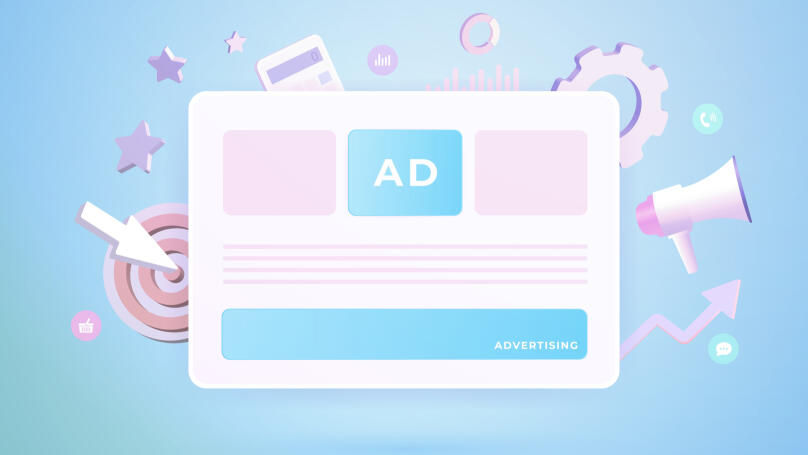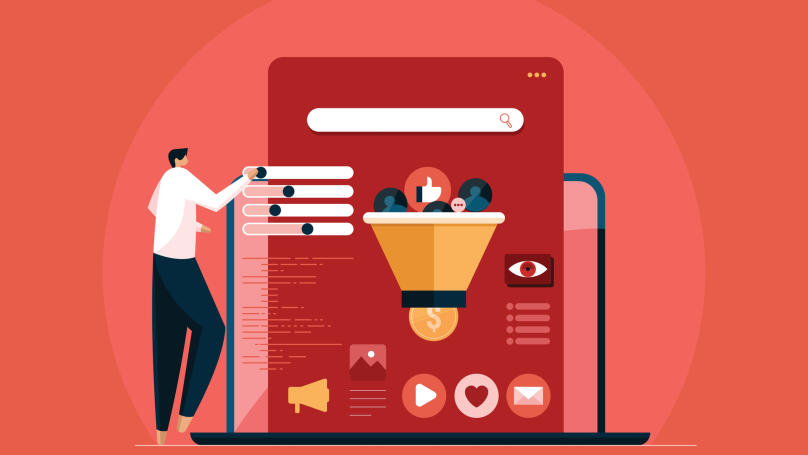Programmatic advertising

Most marketing budgets now go to advertising in digital industries. Moreover, the PwC Global Entertainment & Media Outlook report states that more than 50% of the industry's money go to electronic technology and online communications. On top of that, already 85% of media advertising in the U.S. is bought through automated channels. All this shows the cosmic pace of development of the programmatic ads industry, which we will tell you about in this article.
Definition of programmatic
The meaning of programmatic advertising is using automated technologies to purchase advertising spaces, which is much faster and more convenient than the manual method of buying digital advertising and configuring it. Programmatic marketing also uses data analytics. It works with special software that allows you to automatically sell ad impressions to the target audience (the so-called Sell-Side Platforms) or allows advertisers to buy advertising impressions (these are Demand-Side Platforms). The basis of the software is digital ad boards, where conditional advertising spaces get placed in the auction mode. Simultaneously, the process itself is fully automated.
What is programmatic advertising?
What is a programmatic ad? It is an automatically purchased or automatically sold advertisement (more precisely, a place for it) on a particular channel. The programmatic ad eliminates the need to manually track prices, publish applications, review them and pay. Such a functioning strategy is excellent for use within a large company whose employees are mainly engaged in coming up with marketing creatives and cannot afford to spend much time on such routine trifles.
An explanation of how programmatic advertising differs from display advertising
A programmatic ad is not a particular type of advertising but a set of solutions for buying advertising on various platforms. In turn, display advertising is a separate category of advertising. Although you can also develop it within only one platform, for instance, Google, it is limited in the presentation formats of creatives. Advertising in the display programmatic format is also allowed since display advertising is bought and sold similarly, but automated platforms are not always used for this.
Both programmatic and display advertising allow advertisers to determine the audience to which the creative will get shown, as well as to set a budget, time, and placement locations. Consequently, these two concepts have much more similarities than differences. We can even say they are interrelated, since display advertising can be part of the programmatic advertising, but not vice versa.
Benefits of programmatic advertising

What are the advantages of a programmatic campaign?
- High control. You don't get the same level of transparency from traditional advertising (billboards, etc.) as you do from programmatic advertising. Here, marketers see in real-time how many people click on an advertising video, how many potential customers come from different advertising channels, and so on. The following point follows from this.
- The possibility of not spending money on channels that bring minimal results. You can immediately see the quality of leads (warmed-up or cold) and where they come from for your products. After a month, or even sooner, after you start using programmatic advertising, targeting, and SEO tools, you will understand which ways of communicating with your audience are irrelevant to you. So you will be able to abandon them to save your resources.
- Increased efficiency. By choosing the most effective channels of communication with your audience, you'll be able to attract more leads and increase your average check. After all, advertising is the engine of commerce. The better advertising works, the more money a business makes - it's a universal formula.
- Increased marketing metrics. You're spending money on something that definitely works, meaning the metrics used to track your results will go up. Higher metrics mean a higher salary for you as a professional and the higher likelihood for you to be hired for a new, more attractive position or offered a promotion. In addition, investments in advertising will be more profitable if ads get placed in programmatic media with automatic mechanisms. What's more, programmatic ads will also help you significantly reduce the time you have to work before you launch your campaign - you can get creative in the available hours.
Programmatic display advertising
What is programmatic display advertising? It is the automatic purchase and sale of advertising using specific software. It works like this: you go to a programmatic advertising platform, buy advertising space, indicate the rate you are willing to pay for, for example, 1,000 views of your creative, and wait for the deal to be approved. The higher your offer, the more likely it is to be approved. It is how you buy targeting spots and ad impressions in browsers and websites. Ads can be static and dynamic, which doesn't always make a difference in cost. However, the choice of the audience to whom the creative gets shown, its volume, characteristics, and other demographic indicators can cost more than the ad spot itself.
Programmatic media buyer, a specialist in selling and buying programmatic advertising, does not only use the selling platforms. They also monitor the effectiveness of ads using services such as DoubleClick and Analytics and analyse competitor ads and their possible results. Possible, because the accurate results can only be guessed at, as no company will disclose data on the effectiveness of their advertising campaigns). It allows you to see how programmatic advertising channels work for a particular business, how a potential customer finds you, and how you can simplify and improve that customer journey.
So, how is programmatic media advertising different from advertising in more traditional digital channels like Google Ads? Traditional channels only work in one direction. Google Ads, for example, will offer to show your ads on websites that are part of the Google contextual media network. That's better than nothing, of course, but all the other portals - and there are a lot of them - will be excluded. It is also how other non-programmatic media advertising channels work.
Nevertheless, programmatic advertising covers everything automatically, and the creative can be multimedia, personalised for the user or interactive. That also applies to programmatic mobile advertising. Programmatic advertising buys you future customers and an audience aware of your existence.
Other things you should know about programmatic advertising
Programmatic advertising gets bought through Real Time Bidding (RTB). Data about users who have clicked the link get stored in the Data Management Platform; there is no need to gather this data and try to sort it out in various spreadsheets. Hence, the term "proprietary data" is sometimes used. The data gets offered to you as an advertiser from the platform owner. It is where you buy ads (or from another channel). Furthermore, you can request your data from the social networks where you advertise and search engines.
Programmatic advertising gets managed through the Ad Network, an advertising banner network that feeds ads to websites and contains creatives made to show to audiences. Data about who clicked on these creatives, when and how is then presented to Data Suppliers who either analyse audience segments or provide raw data.
Programmatic buying

The programmatic display advertising you buy generally comes in two types:
- Real-time bidding. These are the same RTB programmes we mentioned above. You make a bid, it goes to auction, you see who made the highest bid, and if it's you. Next, the bid is accepted, and you become the owner of the advertising space. Everything gets automated to the hilt: one advertising space, one bid. There may be more than a million advertisement spots daily, and you will win yours.
- Direct programmatic advertising. Here, bids do not work, but special software is available. Through it, you can buy advertising space for a certain period without taking part in the bidding. Advertisers love direct programmatic advertising: according to eMarketer, about 60% of the money spent on these two types of automated advertising buys comes from it.
Although most prefer not to participate in auctions, they offer the opportunity to buy ad impressions at a heavily discounted price. Yes, the purchase is a one-off, meaning the ad won't run for a long time on the same site location. However, it provides access to the most relevant audience here and now, literally in milliseconds: while the user loads the page, the data about the user gets transmitted to the SSP system (as defined above), and the system sends an auction request to all DSPs connected to it. The DSPs hold an auction for the display. You, as the advertiser, participate in it. As soon as a user loads the page, the ad of the highest bidder gets shown to them. You can't see the bids of other bidders, which, according to analysts and economists, makes this algorithm the fairest for those who pay for the display of advertising.
How does the DSP work?
Through a list of domains
A bid gets made if the SSP sends a request from a specific (advertiser-specified) website. If you care about the context in which your ad is located, this is an option for you.
Using geography
Bidding occurs when a user sends a request from a specific city or postcode. Location is determined by the I.P. address. This targeting is most relevant for the U.S. and U.K.
Through the frequency of impressions
Bidding occurs if the user has not yet seen the same creative a certain number of times. If they have seen the ad twenty times, but have not yet made the target action, like going to the site or ordering a product, showing them the creative is pointless.
By retargeting
A bid occurs if the user has already visited your website but has not made a targeted action and left the site. You can show the user a personalised banner based on what services or products they have viewed. This mechanism is called dynamic creative optimisation.
Programmatic advertising platforms

Below, we have compiled the best platforms to use when working with programmatic advertising.
- PubMatic. Many advertising formats, many channels, an analytics section, and a refund option. The service processes more than one trillion bids per day.
- MediaMath. Comprehensive and easy campaign management, easy user data integration, high-quality customer service and technical support.
- The Google Ad Manager helps to monetise content and is quick and easy to set up, but it does not always ensure your ads get shown to the most relevant audience.
- Adobe Advertising Cloud. Specialises in video, display, native ads, search engine ads, audio ads, and impressions on Smart T.V. Quite a complex interface, but well worth exploring - Adobe maximises the return on your advertising investment.
- The War Room offers over 90,000 ad networks and integrates software and artificial intelligence with analytics from market-leading professionals.
- AdRoll. Ad templates, quality targeting clearly to the chosen target audience, and a large amount of data for analytics on the result of the creative display.
- Amobee. It combines several formats of programmatic advertising and coordinates various advertising campaigns and creatives from several communication channels with the audience.
- SmartyAds. Increases CTR and conversion rates through a range of services for advertisers and website owners where ads get shown.
- Criteo. Works with website owners to help them redirect user data and generate revenue from selling advertising spots.
- Xandr. A classic platform for buying and selling programmatic advertising, which offers extensive data sampling and analytics tools.
- Lotame. Ad exchange for display in browsers and on mobile devices. Inside are a set of tools to manage ad impressions and the ability to buy impressions for a ready audience segment.
- The Trade Desk is a marketplace for website owners selling advertising space. It contains "double modelling," a feature that helps advertisers reach new audience segments.
Programmatic advertising examples
The most prominent examples of programmatic advertising are ads in your search engine. Google introduced the option to purchase ads in 2014; since then, the formats in which they get presented to users have only improved. Moreover, the corporation itself promoted its search engine in this way. That resulted in a 50% increase in brand awareness, which further reduced the price per thousand impressions by 30% compared to the previous year's purchase of programmatic advertising.
Programmatic advertising also works well for magazines. The Economist, for instance, attracted 650,000 potential customers through its programmatic campaign, increased brand awareness by 65%, and gained one million new unique visitors to its website and nearly 10,000 new subscribers, bringing the media $15 million. Additionally, the publication's U.S. audience grew by 22%, and the willingness to recommend the media to friends increased by 10%. To achieve this result, the Economist's marketers offered personalised advertising to different audience segments divided by areas of interest. In total, they created more than 60 advertising creatives.
Offline businesses are also actively using programmatic campaigns. For example, with the help of a series of creatives, airline operator AirAsia got a 30x return on the money spent on advertising. The creatives targeted three customer groups: regular travellers, those who flew with AirAsia after one of the company's planes crashed in 2014, and those who have not flown with it since then. Facebook was the leading platform for publishing ads. All the creatives were unique and tailored to the audience: some highlighted bargain fares for frequent travel destinations, others included a humorous video, and some put an emphasis on technology and safety. And it worked!























